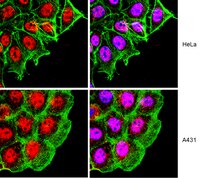07-1781 Sigma-AldrichAnti-RAD50 Antibody
Use Anti-RAD50 Antibody (Rabbit Polyclonal Antibody) validated in ICC, WB to detect RAD50 also known as RAD50 (S. cerevisiae) homolog.
More>> Use Anti-RAD50 Antibody (Rabbit Polyclonal Antibody) validated in ICC, WB to detect RAD50 also known as RAD50 (S. cerevisiae) homolog. Less<<Recommended Products
Overview
| Replacement Information |
|---|
Key Specifications Table
| Species Reactivity | Key Applications | Host | Format | Antibody Type |
|---|---|---|---|---|
| M, H, R | ICC, WB | Rb | Affinity Purified | Polyclonal Antibody |
| References |
|---|
| Product Information | |
|---|---|
| Format | Affinity Purified |
| Control |
|
| Presentation | Purified rabbit polyclonal antibody precipitated in a solution of 50% saturated ammonium sulfate and PBS containing no preservatives. |
| Quality Level | MQ100 |
| Physicochemical Information |
|---|
| Dimensions |
|---|
| Materials Information |
|---|
| Toxicological Information |
|---|
| Safety Information according to GHS |
|---|
| Safety Information |
|---|
| Packaging Information | |
|---|---|
| Material Size | 100 µg |
| Transport Information |
|---|
| Supplemental Information |
|---|
| Specifications |
|---|
| Global Trade Item Number | |
|---|---|
| Catalog Number | GTIN |
| 07-1781 | 04053252677861 |
Documentation
Anti-RAD50 Antibody SDS
| Title |
|---|
Anti-RAD50 Antibody Certificates of Analysis
| Title | Lot Number |
|---|---|
| Anti-RAD50 - 2492819 | 2492819 |
| Anti-RAD50 - 3163552 | 3163552 |
| Anti-RAD50 - 3902930 | 3902930 |
| Anti-RAD50 - NG158684 | NG158684 |
| Anti-RAD50 -2858457 | 2858457 |













